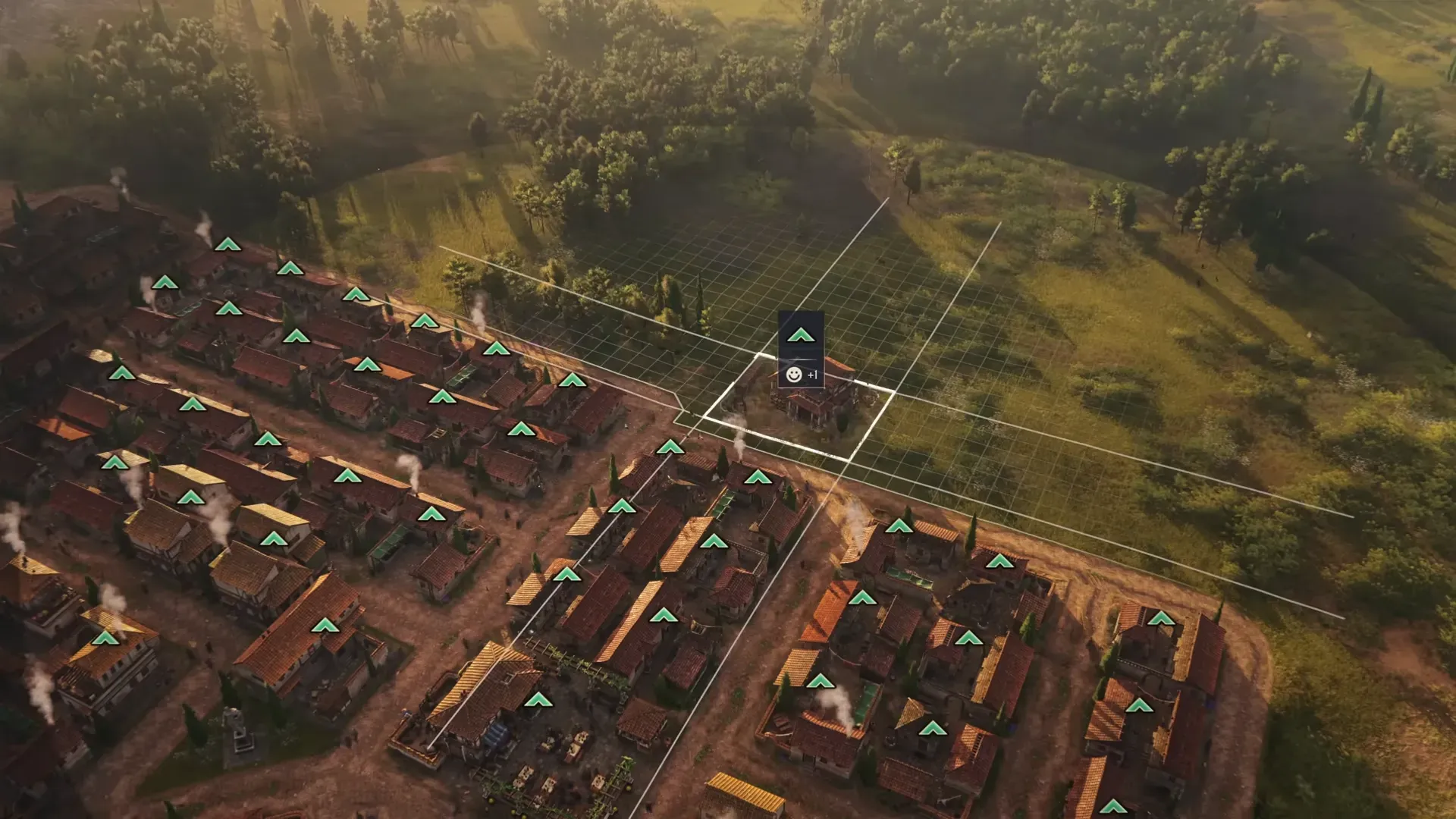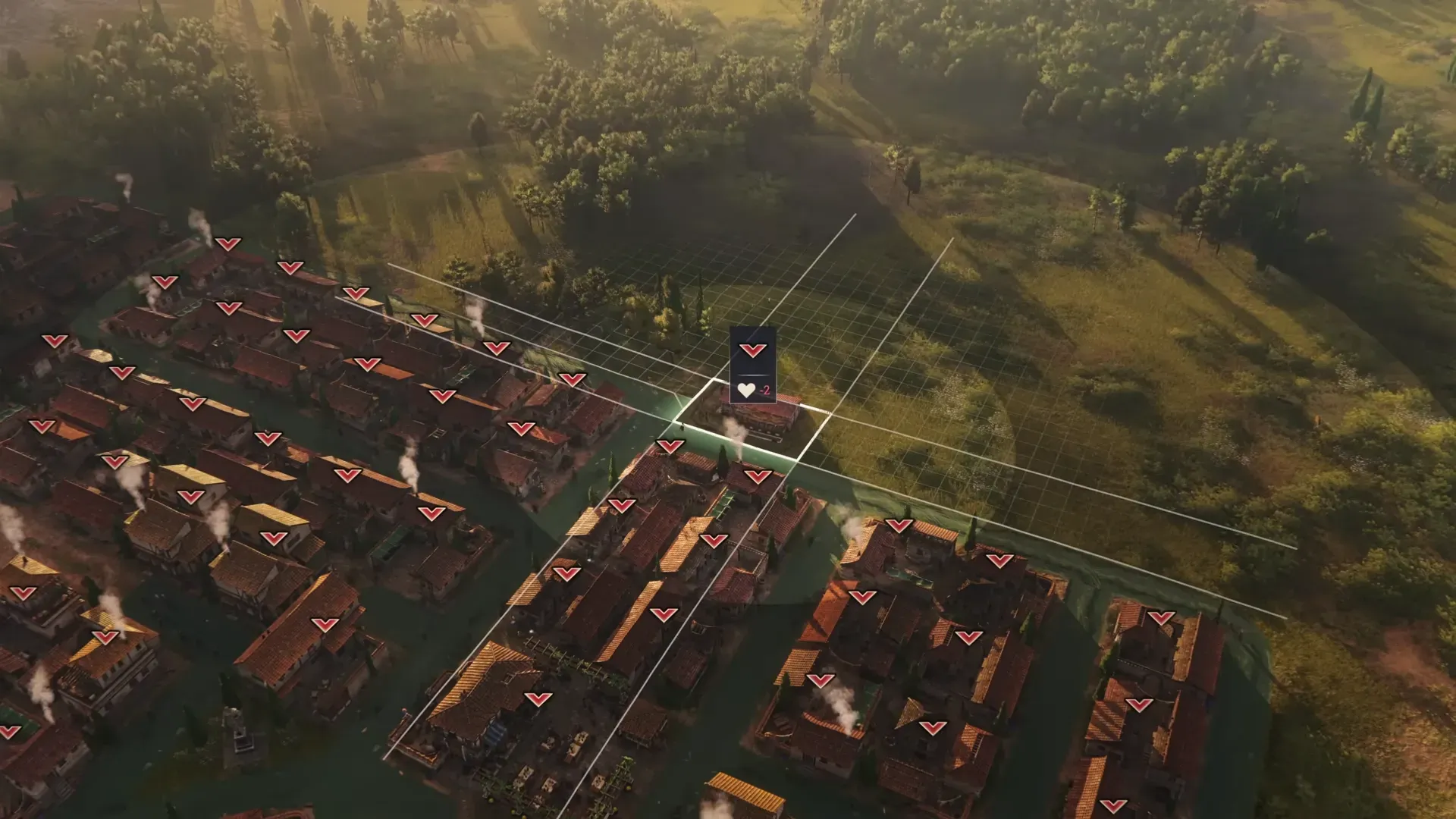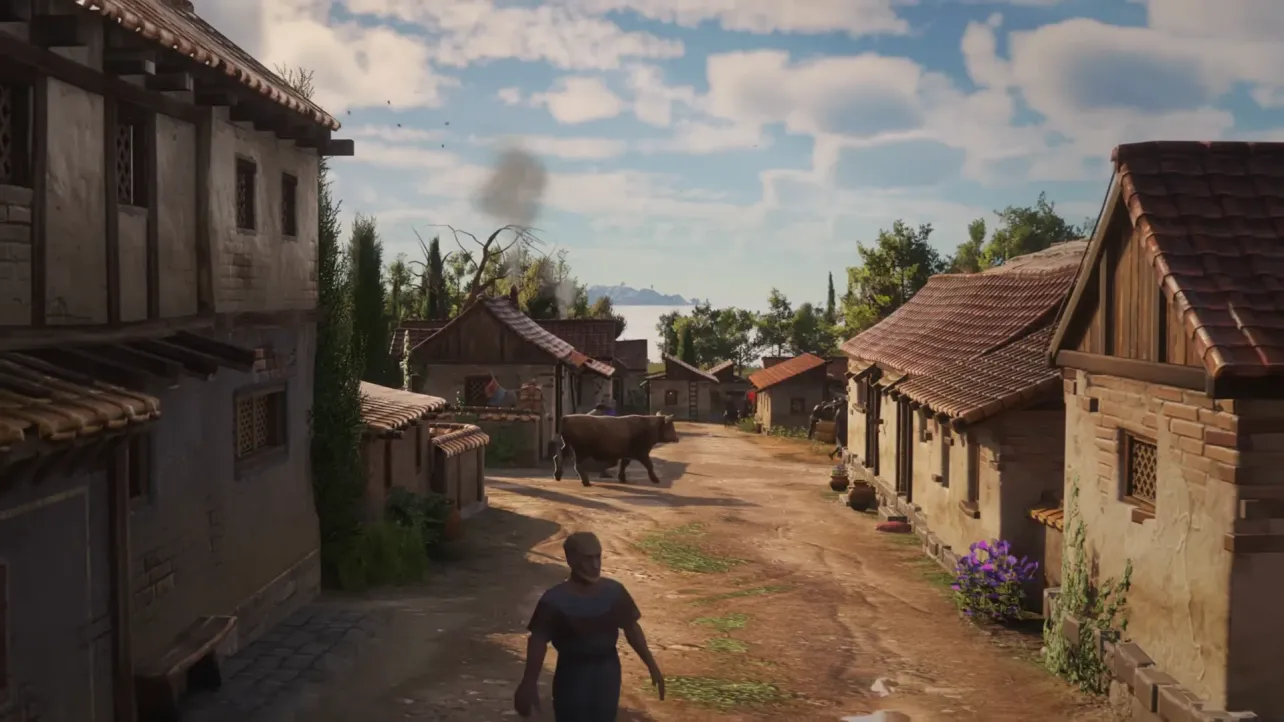Health and happiness in Anno 117 are citywide attributes that trend downward as your settlement grows. When “City Status” rises with population, baseline penalties apply to fire safety, health, and happiness. The game gives you clear levers to offset that pressure: coverage buildings, careful placement of production, late‑game infrastructure, and optional deity bonuses. Watch the top‑right panel for warnings, and pay attention to the green/red arrows that appear when placing buildings—these show how a structure will affect nearby tiles.
Increase health in residential areas
- Place Medici (City Watch) where houses are dense. Medici raise the health of all buildings in their area and dispatch healers during outbreaks. Coverage matters—keep them close to what you want to protect.
- Build Latrines within housing clusters. They provide a direct health boost to nearby residences.
- Unlock and add Aqueducts when available. Aqueducts provide a large improvement to city safety, and contribute strongly to fire safety; they are designed to stabilize big cities that struggle with incident risks.
- Keep disease‑risk production away from homes. Pig Farms reduce nearby health, and Charcoal Burners lower both health and fire safety around them. Isolate these buildings and connect them by road to warehouses instead of residences.
- Use equipment items that add flat health bonuses on relevant service buildings when available. These can quickly pull a neighborhood out of the red.
- Consider a deity that supports health output. Cernunnos increases production of building materials and allows residences to produce additional health and knowledge, which passively raises your baseline.
Tip: Coverage buildings only help what they can “see.” Keep roads clear and ensure no gaps in the street network between Medici, Latrines, and the homes they serve.

Increase happiness in residential areas
- Place Custodes (City Watch) to raise local happiness and respond to riots. Use them like anchors in your residential cores.
- Use cultural and positive‑aura buildings. Theaters increase happiness and also contribute fame and lore. A Dairy provides a happiness bonus to nearby buildings; placing one at the edge of a residential district delivers a steady local uplift without clogging the core with production.
- Add small Lavender Fields near homes. Residents gain a point of happiness when they live close to lavender plots.
- Push “unpleasant” production outside city limits. Tanners and Garum Works reduce happiness for nearby buildings. Keep them remote, near a warehouse, and away from any house, market, or service cluster.
- Leverage items that grant flat happiness bonuses where possible. A single equipped service building can turn a borderline district positive.
Note: Positive effects stack when coverage areas overlap. Two different happiness sources touching the same homes can offset a sizable citywide penalty.
Placement and stacking mechanics that matter
- Area effects stack—both good and bad. Clustering multiple buildings with the same negative aura intensifies penalties. For example, bunching several Bakeries together amplifies fire risk to everything in range. Spread such buildings out, or buffer them with Vigiles and aqueduct coverage.
- Read the arrows. When positioning a building, green arrows signal a local benefit; red arrows warn of a penalty. Rotate and nudge placements to maximize green arrows on housing and civic buildings while steering red arrows toward warehouses or empty buffer strips.
- Plan “clean cores” and “dirty belts.” Keep residences, markets, Custodes/Medici, theaters, and small cultural boosts in the core. Create a belt or peninsula for odor, smoke, or noise producers (tanners, garum, pig farms, charcoal burners), linked by roads to depots—not to your housing grid.

Quick recovery when health or happiness goes red
- Pause and diagnose. Open the top‑right alerts and zoom to the flagged neighborhoods. Look for clusters of negative‑aura buildings or gaps in service coverage.
- Relocate the culprits. Move pig farms, tanners, garum works, charcoal burners, and clustered bakeries away from residences. One relocation can flip an entire block from negative to positive.
- Drop coverage where it counts. Add a Medici for health or Custodes for happiness in the densest affected area. Slot items that add flat bonuses if available.
- Layer a positive aura. Place a Dairy on the edge of the district, plant small lavender fields between housing blocks, or build a Theater if unlocked.
- Strengthen the city backbone. As your city grows, build or extend aqueduct segments to reduce incident pressure, which helps health and happiness remain stable.
- Use your patron deity. Switching or assigning an island to Cernunnos can raise baseline health via residence output. Apply where the penalty is hardest to offset with placement alone.
Common building impacts and placement advice
| Lever | Affects | Effect summary | Placement advice |
|---|---|---|---|
| Medici (City Watch) | Health | Raises local health; deploys responders during outbreaks | Center of housing clusters; ensure full road coverage |
| Latrines | Health | Improves general health of nearby residences | Interleave within residential blocks |
| Aqueducts | Health, Fire safety | Large stability boost for incident‑prone cities | Main boulevards through dense districts; extend as you expand |
| Custodes (City Watch) | Happiness | Raises local happiness; responds to riots | Near markets and plazas serving many homes |
| Theater | Happiness | Increases happiness; also provides fame and lore | Within walking range of the largest residential area |
| Dairy | Happiness | Provides a happiness aura to nearby buildings | Edge of housing to deliver the bonus without crowding core |
| Lavender Fields | Happiness | Residents near lavender gain a happiness point | Small plots between or beside housing rows |
| Pig Farm | Health (negative) | Reduces health for nearby buildings | Remote production belt; near a warehouse, not homes |
| Tannery | Happiness (negative) | Lowers happiness of surrounding buildings | Industrial zone away from the city core |
| Garum Works | Happiness (negative) | Reduces nearby happiness | Harbor‑adjacent but separated from residences |
| Charcoal Burner | Health, Fire safety (negative) | Lowers health and increases fire risk around it | Isolate in forests; only near a warehouse |
| Bakery (clustered) | Fire safety (negative) | Stacked debuff raises fire risk to neighbors | Spread out; buffer with Vigiles and aqueduct coverage |
| Items (blue rarity, etc.) | Various | Add flat bonuses (e.g., +health or +happiness) to covered areas | Equip on City Watch or civic buildings serving many homes |
| Cernunnos (deity) | Health, Knowledge | Residences produce additional health and knowledge | Assign to islands with persistent health deficits |
Growth pressure and how to stay ahead
As your city ranks up, global penalties from City Status make health and happiness harder to maintain. The safest way to grow is to expand housing within existing service radii first, then add a new ring of services before pushing further outward. Each time you add a production sector, check for red arrows and spread out any building with a known negative aura. Layer City Watch coverage, then add cultural or positive‑aura buildings to lock in gains. Later unlocks such as aqueducts exist precisely to counter the higher risks that come with scale.
Healthy, happy cities rely on placement discipline. Keep unpleasant production far from homes, saturate dense districts with Medici and Custodes, and layer small, reliable uplifts like Dairy auras and lavender fields. Use the arrows during placement and the top‑right alerts during play to course‑correct quickly before penalties cascade into incidents.

